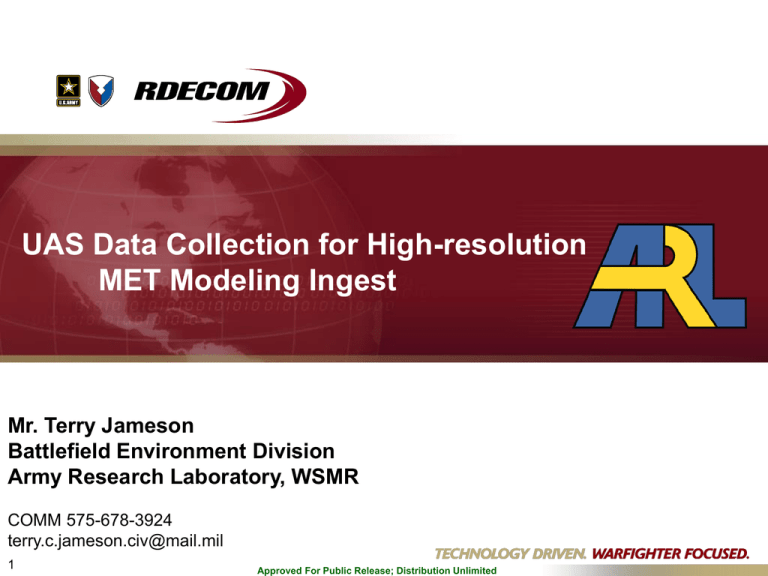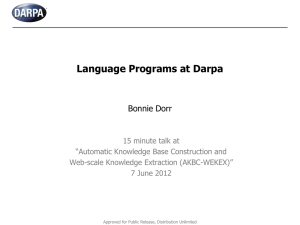Presentation
advertisement

Approved For Public Release; Distribution Unlimited UAS Data Collection for High-resolution MET Modeling Ingest Mr. Terry Jameson Battlefield Environment Division Army Research Laboratory, WSMR COMM 575-678-3924 terry.c.jameson.civ@mail.mil 1 Approved For Public Release; Distribution Unlimited Approved For Public Release; Distribution Unlimited Weather Prediction Models Numerical Weather Prediction (NWP) Models • Predictions of basic Met parameters (winds, temperature, pressure, humidity) • Predictions of derived parameters (turbulence, visibility, cloud layers, etc.) • Predictions at 3-D grid points ( ~ 30 mi. down to ~ 8 mi. horizontal spacing) • Predictions out several hours - up to many days • Research-grade models (one-hour predictions – 0.6 mi. grid spacing) Models require Met data observations input for initialization • Surface weather stations (manned and automated) – little help for upper atmosphere • Doppler weather radar (intensity and motion within storms) – good info but only when storms are present • Satellite observations of winds and temps (very coarse vertical resolution) • Vertically-pointing wind profiling radars – few locations even in U.S. • Weather balloons (winds, pressure, temperature, humidity) ~ 70 stations in Lower 48, ~700 world-wide Twice-daily balloon launches Mainstay of NWP model input since its inception in late ‘50s-early 60’s 2 Approved For Public Release; Distribution Unlimited Approved For Public Release; Distribution Unlimited But there’s a Problem In the U.S. all of the above are available, but….. • Problem is: All of the above leave many gaps (time/space), especially for high-resolution models • Problem is: In/near the battlefield, only a very few weather balloon and surface observation stations exist • Problem is: Those few stations can be sporadic in their observations Bottom line: WE NEED MORE INPUT MET DATA! 3 Approved For Public Release; Distribution Unlimited Approved For Public Release; Distribution Unlimited In-situ Obs from UAVs Data collected from UAVs - What are we up against? • Certainly many UAVs have a temperature sensor/readout, plus GPS winds BUT… • Are the data just displayed to the operator? – can’t use in modeling • Are the data recorded at the ground station? – probably not • Are the data recorded on-board somehow? – probably not • Are those data date/time/location-stamped? • What about pressure and humidity? – need those parameters as well • How to QC the data? – bad data or wrong time/place = poor performance. • How to format the data? – models are very picky! 4 Approved For Public Release; Distribution Unlimited Approved For Public Release; Distribution Unlimited TAMDAR-What is it? TAMDAR: (Tropospheric Airborne Met DAta Reporting) • Small meteorological (Met) data sensing/transmitting instrument • AirDat, LLC • Installed on ~150 regional commuter airliners • Collects Met data for ingest into Numerical Weather Prediction (NWP) Models TAMDAR-U (TAMDAR-UAV) • TAMDAR downsized for installation on UAVs • Stringent restrictions on Size, Weight, and Power (SWaP) requirements 5 Approved For Public Release; Distribution Unlimited Approved For Public Release; Distribution Unlimited AirDat’s Commercial TAMDAR® System GLOBAL SATELLITE NETWORK TAMDAR DATA AIRBORNE SENSORS TAMDAR DATA TRANSPORT AIRCRAFT SATELLITE GROUND STATION UAV / UAS SECURE DATA CENTER HIGH-RES FORECAST MET REPORT DISPERSION MODEL FIRING SOLUTION FORECAST MODELING NOWCAST QA & FORMATTING FORECAST / ANALYSIS USERS MET DATA USERS TAMDAR SYSTEM ARCHITECTURE LATENCY < 30SEC GLOBALLY FROM TIME OF OBSERVATION Know the Weather 6 Information used with permission from AirDat, LLC Approved For Public Release; Distribution Unlimited Approved For Public Release; Distribution Unlimited The Team NMSU PSL/Technical Analysis & Applications Center (TAAC) • The Aerostar-B UAV • Established COA in southern NM • Substantial experience in conducting instrumentation flight tests AirDat, LLC • The TAMDAR • Instrumentation facilities (Lakewood, CO) • Data ground station and NWP modeling facilities (Florida) • Substantial experience in instrumenting commercial airline fleets • Substantial experience in ingesting TAMDAR data into models ARL • Long-term history of DOD weather research and support • High-resolution, battlefield-scale NWP model development • Substantial experience in assessing model performance 7 Approved For Public Release; Distribution Unlimited Approved For Public Release; Distribution Unlimited TAMDAR-U Sensor (Prototype) Mounted on Modified Aerostar Nose Cone Prototype TAMDAR-U CFD Analysis Measures and Reports -Ice presence -Relative Humidity -Median and peak turbulence -Indicated and True Airspeed -Static pressure and pressure altitude -Winds Aloft (Speed and Dir) -Air temperature (Mach corrected) -GPS Position and Time -Additional sensing possible (CBRN) -Encryption Possible 8 Information used with permission from AirDat, LLC Approved For Public Release; Distribution Unlimited Know the Weather Approved For Public Release; Distribution Unlimited TAMDAR-U Sensor (Prototype) - SWaP LRU Dimensions (Volume) Weight Max Power (Estimated) Probe (External) 2.6”x2.5”x0.7” 3.6” Pitot 2.2 oz (62 g) N/A Data Acquisition, Processing, and Communications (Internal) 40 in3 12.2 oz (346 g) 8.4W 40 in3 Internal 14.4 oz (408 g) (reductions possible) (reductions possible) TOTALS 8.4W (reductions possible) Know the Weather 9 Information used with permission from AirDat, LLC Approved For Public Release; Distribution Unlimited Approved For Public Release; Distribution Unlimited The Aerostar UAS 10 Approved For Public Release; Distribution Unlimited Approved For Public Release; Distribution Unlimited The Airspace & Model Domain 32o 46.00’ N 107o 50.00’ W 40.00’ N 107o 50.00’ W 31o 11 Approved For Public Release; Distribution Unlimited 32o 46.00’ N 106o 30.00’ W 31o 40.00’ N 106o 30.00’ W Approved For Public Release; Distribution Unlimited Experimental Approach Collect TAMDAR-U data within model domain for three-hour flight Reformat and archive data for later analyses Run model in data-ingest mode for 3-hrs, simulating ingest during flight Continue model run after data ingest cutoff – generate 6 hr forecast Compare output charts with/without TAMDAR-U ingest Compare against any available observations 12 Approved For Public Release; Distribution Unlimited Approved For Public Release; Distribution Unlimited 13 Approved For Public Release; Distribution Unlimited Approved For Public Release; Distribution Unlimited Example “Test Card” 32o 46.00’ N 107o 50.00’ W 32o 40.00’ N 107o 34.00’ W Point B 32o 46.00’ N 106o 30.00’ W Normal climb to 10,000’ MSL 305O / 40 nm 125O After T/O: / 40 nm LRU A/P 32o 17.21’ N 106o 55.19’ W Point A Course 305o True At 10,000 MSL, normal descent to 7,000’ MSL At Point B, standard rate turn to 125o True Return to Point A (LRU) 31o 40.00’ N 106o 30.00’ W 31o 40.00’ N 107o 50.00’ W 14 SOUTHERN BORDER ADIZ Approved For Public Release; Distribution Unlimited At 65 kt IAS (approx. 75 kt TAS), the R/T to Pt. B will take approximately 1.15 hr. Approved For Public Release; Distribution Unlimited Example Results 15 Approved For Public Release; Distribution Unlimited Approved For Public Release; Distribution Unlimited What did we find? TAMDAR sensor could be adequately downsized/configured for UAV ops TAMDAR-U data successfully assimilated, formatted, ingested given erratic flight patterns and altitudes of UAV missions From a qualitative standpoint, wind flow patterns looked more realistic over and near mountain slopes with TAMDAR-U data ingest Few observations within most of the domain for quantitative evaluation Weather balloons launched at LRU airport compared against vertical profiles from the models were inconclusive Very benign weather case-study days were not conducive to finding clear distinctions between models 16 Approved For Public Release; Distribution Unlimited Approved For Public Release; Distribution Unlimited What’s next? Collect TAMDAR data within a data-rich model domain (commuter fleet) Run model ingesting or withholding data as before Select some “bad weather” case-study days (rainfall, strong winds, etc.) Conduct quantitative statistical analyses, observation points versus forecasts 17 Approved For Public Release; Distribution Unlimited








